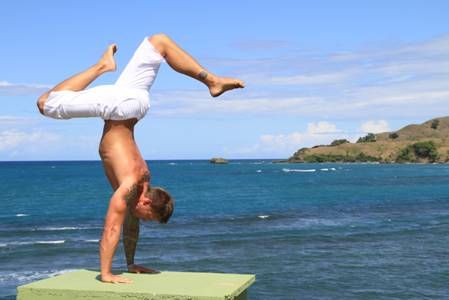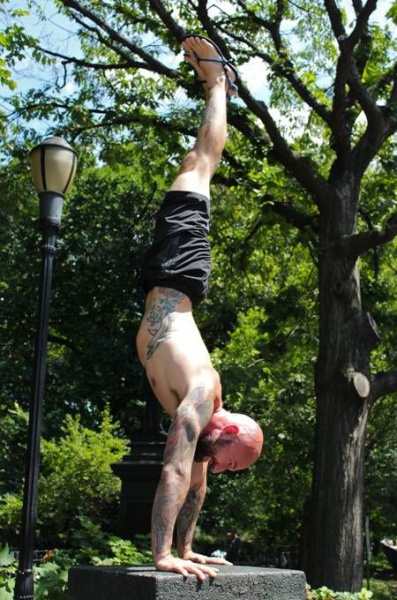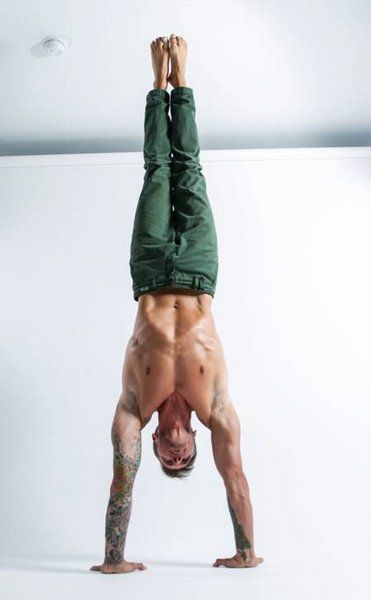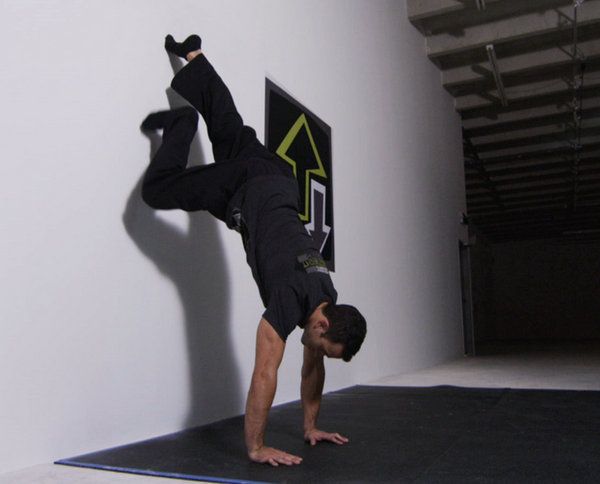
Yeah, it’s a bold statement, but hear me out. The mechanics of successfully performing a handstand will amp up all of your other exercise endeavors, making you stronger, more stable, and better coordinated, while the discipline required to master the move will make you a better human being overall. It will force you to take a long, hard look at the time you are willing to invest in reaching a specific goal. It will also allow you to win money in a bar bet, steal the spotlight at any wedding and of course get the girl (or guy). Results may vary on the last three.
For thousands of years, athleticism has been demonstrated through feats of bodyweight strength and skill, with fit individuals judged not just by their bodies’ tone, but by how skillfully they could use their bodies. Even in the golden age of bodybuilding, Arnie and the boys were known to challenge each other post workout with hand balancing and bodyweight strength contests. We then saw a lull in these activities, with the popularization of the fixed-axis weight-lifting machine and single-plane isolation “robot training,” but luckily for you and me (and the human race), the idea of skills practice and self-mastery is making its way back into fitness.
My favorite field, progressive bodyweight training, includes a multitude of exercises that are always sure to elicit an envious “I’ve always wanted to do that!” Pistol squats, muscle-ups, human flags, HAND BALANCING – these moves are sure to catch the eye of any fitness enthusiast. And the great thing is that any of these feats are possible to learn with the proper progression training, time commitment, and, most importantly, consistency.
Just as it takes a baby about 12 months of daily conditioning and practice to eventually stand on their own, it can take an adult months or years of repeated practice to build the neural grooves associated with a perfect handstand. Are you willing to invest that kind of time? I can guarantee that it will be one of the most humbling and gratifying journeys that you’ll experience.
While performing a great handstand is certainly a worthy goal unto itself, you’ll find that the skills you build in the process will transfer over into your other training, making you a better athlete and enhancing your quest toward a better body. Here are some examples of the tremendous carry-over you’ll see:
The Kinetic Chain
Let’s start with a simplified definition of the very complex concept of the kinetic chain: everything in our body is connected to everything else. A handstand is a prime example of the connectivity of the kinetic chain, with each position, alignment, and movement requiring constant communication and neuromuscular efficiency in order to maintain that perfect balance. If just one thing changes during our hand balance, such as flexing our toes instead of extending them, then our body must immediately adjust to this new shift.
Hand balancing is, obviously, performed on your hands, so that’s a great place to start thinking about how everything is connected. Your fingers are some of the densest areas of nerve endings on the body, and have the best tactile feedback and positioning capability. Kicking up into your handstand initiates a sort of neuromuscular “super highway,” with all of those little finger receptors sending and receiving information throughout the body. Your body’s communication must be perfectly orchestrated to keep you in balance, like a super effective emergency dispatcher taking calls, sending reinforcements, and keeping you safe (aka preventing you from crashing onto your head.)
The body has to adjust to the hand placement in relation to the shoulders; to the elbows being over the wrists but under the shoulders; and the hips, where are the hips in relation to the shoulders?; and it goes on. So if we do this efficiently, and amp up our body’s abilities to communicate and make minute adjustments in a flash, you may already see how handstand training can benefit other athletic goals. But, I promised that handstands will make you better at everything, so let’s keep on going.

Internal Tension
A tense body is a strong body. Why is it so easy to balance a ruler or a bat vertically on your hand? Because the object is rigid, with no bends or “leaks.” Whether you are lifting your own body or grinding out a 1000 pound deadlift, the concept is the same – you need to create a rigid structure from which you can pull, push, lift or balance. In Progressive Calisthenics, there is no room for any part of your body to lose connection or leak tension, and you learn very quickly about any leaks in your chain. Mastering total body tension will not only accelerate your handstand training, but will be directly applicable to most of your other training as well.
Grip Strength
In addition to “tense the whole body,” you’ll hear a lot of HB coaches tell you to “grip the ground.” In our foot we have the luxury of a heel which plays a clever game of leverage to make walking and standing fairly easy tasks. Unfortunately, we don’t have the same advantage in our hands. So, the fingers must DIG into the ground, countering the body’s tendency to over balance (topple over), or let up to counter an underbalance. It’s this constant battle between the finger extensors and flexors trading off between the rolls of agonist and antagonist that keeps us upright. And along the way you’ll be conditioning for some brutal forearm strength.
Shoulder Stability
Few exercises can compare to a handstand for building shoulder stability. And let’s face it, nobody is going to be staring in amazement while you’re performing more band internal/external shoulder rotations.
The shoulder – so incredible, so complex, and so commonly abused – can be an important source of power, but also a source of hidden weakness impacting your training in ways you don’t even realize. Over repetition syndrome, poor form, and especially faulty postures can create imbalances that lead to injury or instability. But even if you don’t feel pain, if your body senses a weakness in the shoulder, it will automatically restrict the amount of power passing through that joint, and can actually dial down the surrounding muscle excitation. I’m going to assume that everyone would rather be tapping into all of their strength for their efforts. As the saying goes, “you can’t shoot a cannon from a canoe.”
In Hand Balancing, the shoulder is the first line receiving all of that information from the sensors in the hands and forearm musculature, reacting to the head and hands below and the rest of the body above. The muscles at the shoulder joint have to fire up like a synchronized light show to adjust to the constantly changing center of gravity over such a limited base of support, from the deeper muscles like Supraspinatus, Infraspinatus, Teres Minor, and Subscapularis (rotator cuff), to the bigger and more powerful Lats, Pecs, and Delts. Even with the elbow completely locked, the heads of the Bicep and Triceps that cross the shoulder joint play a role in stabilizing the shoulder. And that’s not even mentioning the other muscles that keep your Scapula strapped to your back.
Simply put, handstands will make you stronger through increased activation and stabilization.

Spinal Stabilization
Handstands require not just spinal, or core, stabilization, but true multi-planar stabilization involving inversion of the body.
Now, I realize there are many views on spinal stabilization and some debate over its efficacy and “functional” carryover to life or sport (“You have to draw in to activate TVA!” “No, bracing is the only way!” “Let’s fight!”). But we can probably all agree that the surrounding musculature of the spine (ie the core) needs to be able to properly stabilize to protect the spinal cord, and that the spine needs to be able to fight gravity’s constant pull, distributing the load while generating force and, more importantly, accepting external forces (whether that’s gravity, or a linebacker). It flexes, extends, rotates, laterally flexes and in the case of the handstand, stays perfectly still, and STABLE.
When we are upright, we know that the core musculature should be firing to allow for gait pattern as in walking or running, or bending over to snatch up a kettlebell. But get inverted and everything changes. The anchor or base is now the shoulder girdle, sitting on top of those mechanically disadvantaged hands. So now the spinal stabilizers have to figure out how to balance the pelvis over the shoulders, with the big legs riding on top. This is true multi-planar stabilization! In a hand balance, all of the spine’s muscular units have to play their part to keep the spine in perfect alignment – i.e. spinal stabilization.
GETTING STARTED: TUTORIAL
I am constantly asked, “What’s the key to learning handstands?” And there is a clear answer: “To get good at handstands, you practice handstands.” There is no other weighted exercise that will make you better at handstands – you just need to put in the time to practice the handstand-specific progressions and conditioning exercises. It IS skill specific training.
So here’s the part where you get to see what you’re made of. Are you willing to put the time in to taking this challenge on? Are you ready to approach it with discipline, practicing often, even daily if necessary? You are no longer trying to merely increase your reps; now you are working to improve yourself, master difficult skills, and achieve long-term goals.
I can tell you from my own experience that the handstand can be an allusive opponent. I first learned an arch-back style handstand, which is common for most beginners, before I was challenged by a gymnast friend to learn the flat back style. That process of re-educating took months! It was probably a year before I could easily switch between the two, along with other body positions, and stay up for multiple minutes. I learn more about Hand Balancing every single day and am humbled by it constantly. I’m certainly a lot better now than I was a few years ago, and I definitely have more goals yet to reach. It’s clear to me that it’s a life-long practice. There’s no turning back now.
Intro to Handstand Conditioning: The Wall-Assisted Handstand
Begin your handstand training with the simple Wall Assisted Handstand. It may seem like the most basic conditioning exercise, but remember, a baby has to crawl before he could stand. The exercise itself is as simple as it sounds, but I have some tips to help make it wildly successful for you:
-
First of all, you should have your front, not your back, facing the wall. Otherwise you’re automatically training in an arch back handstand. While the arch back is a legitimate handstand in itself, the mechanics are different and you may not get the same benefits I mentioned earlier.
-
Follow these steps to get yourself safely into place: Start by facing away from the wall. Bend forward and place your hands on the ground at roughly shoulder width. Place your feet on the wall and walk them up until the body is elongated. Walk your hands towards the wall until they are about 6 inches or so away from the wall (this may vary – just find a distance that feels comfortable psychologically). The toes should be pointed with the top of the foot flat on the wall.
-
Once in position, SET the body: Grip the ground with your fingertips. Lock the elbows completely, driving down into ground, creating as much space as possible between your toes and the ground. When you successfully fire the traps, the space between your ears and shoulders will close. Squeeze the glutes and quads, and draw in or brace the abdominal wall. Make sure not to hinge at the hips.
-
Don’t forget to breathe!
-
Time yourself to see how long you can hold this perfectly tensed handstand. Your goal is to first work up to one minute, then two. Once you can hold for two minutes, begin bringing your hands closer and closer to the wall.
-
And here’s an important Bonus Tip: If you’re not used to twisting or summersaulting out of a handstand, be sure to leave enough strength to get back DOWN the wall!

Expect to be humbled by this isometric conditioning. But keep up with your handstand practice, and it will absolutely fast track your way to being better at EVERYTHING!
For more information on Hand Balancing, check out our new 5-part video series, Hand Balancing for the Bodyweight Athlete, available as downloads or on DVD.
Mike Fitch is the Founder/President of Global Bodyweight Training, a fitness company providing training, education, and promotion of bodyweight training disciplines, as well as creator of the popular Animal Flow program. Mike’s current interests lie in exploring how bodyweight training disciplines can be integrated with skills-based practices, and multi-planar, fluid movement. He’s been featured in Men’s Health, Shape, and Fitness Magazine, as well as on The Doctor’s, Good Morning America, and LIVE with Kelly and Michael.
